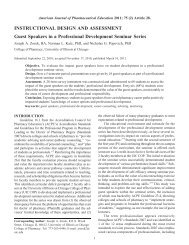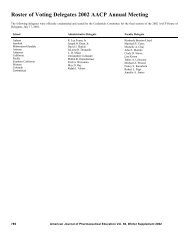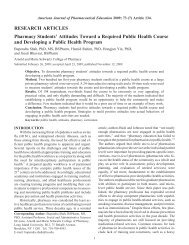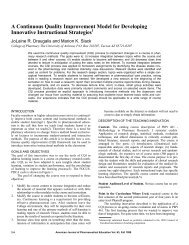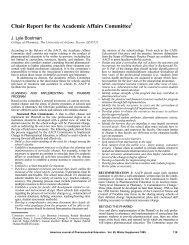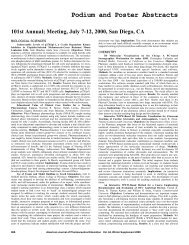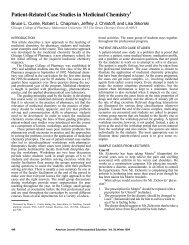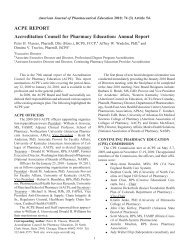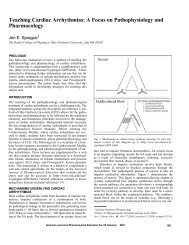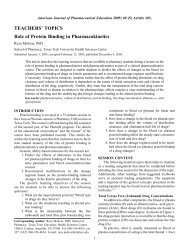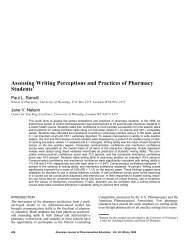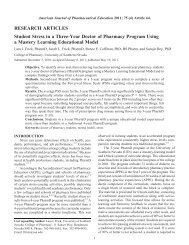Pharmacy Students' Perceptions of Pharmaceutical Care in ... - AJPE
Pharmacy Students' Perceptions of Pharmaceutical Care in ... - AJPE
Pharmacy Students' Perceptions of Pharmaceutical Care in ... - AJPE
Create successful ePaper yourself
Turn your PDF publications into a flip-book with our unique Google optimized e-Paper software.
American Journal <strong>of</strong> <strong>Pharmaceutical</strong> Education 2004; 68 (1) Article 4.<br />
Content analysis <strong>of</strong> technical reports was used to<br />
compare pharmaceutical care employed <strong>in</strong> different<br />
practice sett<strong>in</strong>gs as perceived by pharmacy students.<br />
However, several limitations to the study may have resulted<br />
from us<strong>in</strong>g two different ambulatory care cl<strong>in</strong>ics<br />
for student observation. Differences <strong>in</strong> the cl<strong>in</strong>ic sett<strong>in</strong>gs<br />
<strong>in</strong>cluded patient population served, diseases monitored<br />
(ie, diabetes versus anticoagulation care), age <strong>of</strong> the<br />
patient population, and pharmacists’ <strong>in</strong>teractions with<br />
patients’ physicians (ie, <strong>in</strong>dependent versus onsite physicians).<br />
Also, ambulatory care cl<strong>in</strong>ics reflect a cont<strong>in</strong>uum <strong>of</strong><br />
care, while patients <strong>in</strong> retail sett<strong>in</strong>gs <strong>in</strong>teract with pharmacists<br />
<strong>in</strong> a limited (ie, one-time) counsel<strong>in</strong>g and dispens<strong>in</strong>g<br />
process. This <strong>in</strong>herent difference <strong>in</strong> practice<br />
sites may have also skewed the results <strong>of</strong> the study. For<br />
example, care for patients <strong>in</strong> the cl<strong>in</strong>ic sett<strong>in</strong>g may not<br />
require an extensive counsel<strong>in</strong>g session with openended<br />
questions if that particular patient had been seen<br />
by the pharmacist several times already. Furthermore,<br />
cl<strong>in</strong>ic sett<strong>in</strong>gs require that pharmacists focus on each<br />
patient’s unique problem <strong>in</strong>stead <strong>of</strong> follow<strong>in</strong>g the standard<br />
counsel<strong>in</strong>g and dispens<strong>in</strong>g process that occurs <strong>in</strong><br />
retail sett<strong>in</strong>gs.<br />
Further limitations may also be <strong>in</strong>herent <strong>in</strong> the<br />
study s<strong>in</strong>ce a comparison among the different retail sett<strong>in</strong>gs<br />
could not be made. S<strong>in</strong>ce the students were allowed<br />
to choose the retail sett<strong>in</strong>g <strong>in</strong> which to complete<br />
the project, variations <strong>in</strong> prescription volume, whether<br />
the pharmacy was adequately staffed, and customer<br />
demographics could have <strong>in</strong>fluenced the outcomes reported<br />
<strong>in</strong> the technical reports. All <strong>of</strong> these factors have<br />
the potential to <strong>in</strong>crease barriers to communication. Furthermore,<br />
previous exposure to a particular retail sett<strong>in</strong>g<br />
could have <strong>in</strong>troduced either a positive or negative bias.<br />
Specifically, more students who observed the retail<br />
pharmacy environment identified a lack <strong>of</strong> privacy <strong>in</strong> this<br />
sett<strong>in</strong>g. Inadequate privacy has been identified <strong>in</strong> the literature<br />
as an impediment <strong>in</strong> the delivery <strong>of</strong> pharmaceutical<br />
care <strong>in</strong> the retail sett<strong>in</strong>g. 17 Indeed, several <strong>of</strong> the technical<br />
reports <strong>of</strong> retail sett<strong>in</strong>gs explicitly stated that the<br />
common practice <strong>of</strong> conduct<strong>in</strong>g the patient <strong>in</strong>terview<br />
through the drive-through w<strong>in</strong>dow or to the side <strong>of</strong> the<br />
check-out counter was a barrier to patient care. Students<br />
recognized the importance <strong>of</strong> decreas<strong>in</strong>g barriers <strong>in</strong> order<br />
to achieve good communication. Although communication<br />
is just one component <strong>in</strong> the provision <strong>of</strong> pharmaceutical<br />
care, it has been associated more frequently with<br />
patient satisfaction. 18<br />
The students’ perceptions that cl<strong>in</strong>ics <strong>of</strong>fered a better<br />
educational experience could be expla<strong>in</strong>ed because these<br />
sett<strong>in</strong>gs may allow for the creation <strong>of</strong> a learn<strong>in</strong>g climate<br />
where the teach<strong>in</strong>g encounter is planned <strong>in</strong> advance. 19<br />
Preceptors can create a learn<strong>in</strong>g environment with<strong>in</strong> a<br />
5<br />
cl<strong>in</strong>ic sett<strong>in</strong>g by select<strong>in</strong>g patients that match the abilities<br />
<strong>of</strong> the student and by brief<strong>in</strong>g the student on the patient’s<br />
relevant history prior to the encounter. Preceptors can<br />
also model car<strong>in</strong>g attitudes and behaviors, values, and<br />
patterns <strong>of</strong> th<strong>in</strong>k<strong>in</strong>g <strong>in</strong> addition to cl<strong>in</strong>ical practices. 20,21<br />
Furthermore, students exposed to such a learn<strong>in</strong>g environment<br />
may beg<strong>in</strong> to understand the relevance <strong>of</strong> the<br />
breadth <strong>of</strong> material taught <strong>in</strong> the curriculum. For example,<br />
one student stated <strong>in</strong> the technical report that the fast<br />
pace and structure <strong>of</strong> the cl<strong>in</strong>ic experience made her<br />
aware <strong>of</strong> the preparation that would be needed to take<br />
care <strong>of</strong> patients <strong>in</strong> the future.<br />
CONCLUSIONS<br />
At the end <strong>of</strong> a semester course on patient counsel<strong>in</strong>g<br />
and communication, students rated only 5 <strong>of</strong> 20<br />
pharmaceutical care activities performed by pharmacists<br />
as hav<strong>in</strong>g higher importance than at the beg<strong>in</strong>n<strong>in</strong>g <strong>of</strong> the<br />
semester. When compar<strong>in</strong>g retail and cl<strong>in</strong>ic sett<strong>in</strong>gs for<br />
observation <strong>of</strong> pharmaceutical care activities, students<br />
perceived the application <strong>of</strong> 4 <strong>of</strong> 6 pharmaceutical care<br />
variables as more significant <strong>in</strong> cl<strong>in</strong>ic practice sett<strong>in</strong>gs.<br />
Specifically, the students noted fewer barriers to communication,<br />
more privacy dur<strong>in</strong>g counsel<strong>in</strong>g, and<br />
greater monitor<strong>in</strong>g and assessment <strong>in</strong> the cl<strong>in</strong>ic practice<br />
sett<strong>in</strong>g. Those students also reported hav<strong>in</strong>g a better<br />
educational experience than students who conducted<br />
their observation <strong>in</strong> a retail pharmacy sett<strong>in</strong>g. The<br />
pharmaceutical care variables that did not appear to differ<br />
significantly between retail and cl<strong>in</strong>ic sett<strong>in</strong>gs were<br />
pharmacist’s explanation <strong>of</strong> dos<strong>in</strong>g and provision <strong>of</strong><br />
directions to the patient, and the pharmacist’s use <strong>of</strong><br />
open-ended questions.<br />
Although the specific components <strong>of</strong> pharmaceutical<br />
care and pharmacy care standards and how they are<br />
applied may vary from sett<strong>in</strong>g to sett<strong>in</strong>g, the results <strong>of</strong><br />
this study do not imply that pharmacists serv<strong>in</strong>g <strong>in</strong> retail<br />
environments lack the ability to provide quality pharmaceutical<br />
care. <strong>Pharmaceutical</strong> care can be practiced <strong>in</strong><br />
a variety <strong>of</strong> sett<strong>in</strong>gs <strong>in</strong>clud<strong>in</strong>g outpatient care, cl<strong>in</strong>ic and<br />
retail sett<strong>in</strong>gs, and <strong>in</strong>patient care. 1 In order to enhance<br />
cl<strong>in</strong>ical skills among pharmacists practic<strong>in</strong>g <strong>in</strong> retail<br />
environments, a number <strong>of</strong> tra<strong>in</strong><strong>in</strong>g programs and workshops<br />
have been developed. 22-24 The cl<strong>in</strong>ical skills targeted<br />
for improvement, such as analyz<strong>in</strong>g drug and disease<br />
<strong>in</strong>formation, identify<strong>in</strong>g drug-related problems,<br />
and collect<strong>in</strong>g pert<strong>in</strong>ent patient <strong>in</strong>formation, are the<br />
ones most <strong>of</strong>ten used <strong>in</strong> actual pharmaceutical practice.<br />
22<br />
REFERENCES<br />
1. Hepler CD, Strand LM. Opportunities and responsibilities <strong>in</strong><br />
pharmaceutical care. Am J Hosp Pharm. 1990;47:533-43.<br />
2. Cipolle RJ, Strand LM, Morley PC. <strong>Pharmaceutical</strong> <strong>Care</strong><br />
Practice. New York, NY: McGraw-Hill Companies; 1998.



